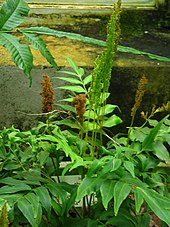Schizaeales
| Schizaeales | ||||||||||||
|---|---|---|---|---|---|---|---|---|---|---|---|---|

|
||||||||||||
| Systematics | ||||||||||||
|
||||||||||||
| Scientific name | ||||||||||||
| Schizaeales | ||||||||||||
| Chimp. |
The Schizaeales are a small order of the class of the true ferns (Polypodiopsida) with only four genera distributed over three families . Most species thrive in the tropics .
description

The fertile sporophylls have a different structure than the sterile trophophylls. There are no defined sori as in the other leptosporangiate ferns. The sporangia have a transverse, continuous annulus below the tip .
The leaves can be grassy-dichotomous, pinnate, or even spiraling.
Systematics and distribution
The order Schizaeales is the sister group of the "core Leptosporangiaten ferns" from Polypodiales , tree ferns and Salviniales . The Schizaeales order has been known since the Jura .
The species predominantly thrive in the tropics . All species grow terrestrially .
The Schizaeales order is monophyletic and contains three families:
- Climbing fern family (Lygodiaceae): There is only one genus:
- Climbing ferns ( Lygodium Sw. ): The approximately 26 species grow terrestrially throughout the tropics. The rhizome is creeping, slender and hairy. Climbing the leaves, growth not determined. The leaf veins are free or anastomosing. The sori are on lobes on the last leaf segments. The sporangia stand individually (one per sorus) and are covered by an indusium- like structure. 128 to 256 tetrahedral and triple spores are formed per sporangium . The gametophytes are green, heart-shaped and live above ground. The basic chromosome number is x = 29 or 30.
- Flower fern family (Anemiaceae): There is only one genus:>
- Flower ferns ( Anemia Sw. ): The over 100 species grow terrestrially, mainly in the Neotropic . The rhizome is creeping or ascending and hairy. The leaves have limited growth and are dimorphic. The leaf veins are dichotomously branched and end free. The sporangia are usually on the basal pair of plumage, which is highly modified and vertically upwards. 128 to 256 tetrahedral spores with parallel grooves are formed per sporangium. The gametophytes are green, heart-shaped and live above ground. The basic chromosome number is x = 38.
-
Schizaeaceae : The Cretaceous genus Schizaeopsis is considered the oldest fossil of this group. The species of this pantropical family grow terrestrially. The leaves are simple and linear or fan-shaped with dichotomous, free-ending leaf veins. The sporangia are at the margins on branched or unbranched projections of the leaf tip. There are no Sori or Indusia. The basic chromosome number is x = 77, 94 or 103. This subheading includes about 30 species in the two genera:
- Actinostachys Wall. , with non-green, bulbous gametophytes, includes about five species.
- Schizaea Sm .: The 20 or so species thrive mainly in the tropics. The gametophytes are green and thread-like.
swell
literature
- Alan R. Smith, Kathleen M. Pryer, Eric Schuettpelz, Petra Korall, Harald Schneider, Paul G. Wolf: A classification for extant ferns. In: Taxon. Volume 55, No. 3, 2006, ISSN 0040-0262 , pp. 705-731, abstract, PDF file .
- Kathleen M. Pryer, Eric Schuettpelz, Paul G. Wolf, Harald Schneider, Alan R. Smith, Raymond Cranfill: Phylogeny and evolution of ferns (Monilophytes) with a focus on the early leptosporangiate divergences. In: American Journal of Botany. Volume 91, No. 10, 2004, pp. 1582-1598, DOI: 10.3732 / ajb.91.10.1582 .
- Warren H. Wagner Jr .: Schizaeaceae. In: Flora of North America Editorial Committee (Ed.): Flora of North America North of Mexico . Volume 2: Pteridophytes and Gymnosperms . Oxford University Press, New York / Oxford a. a. 1993, ISBN 0-19-508242-7 , pp. 112–113 (English, limited preview in Google Book Search). on-line.
- Clifton E. Nauman: Lygodiaceae. In: Flora of North America Editorial Committee (Ed.): Flora of North America North of Mexico . Volume 2: Pteridophytes and Gymnosperms . Oxford University Press, New York / Oxford a. a. 1993, ISBN 0-19-508242-7 , pp. 114–116 (English, limited preview in Google Book Search). on-line.
- John T. Mickel: Anemiaceae. In: Flora of North America Editorial Committee (Ed.): Flora of North America North of Mexico . Volume 2: Pteridophytes and Gymnosperms . Oxford University Press, New York / Oxford a. a. 1993, ISBN 0-19-508242-7 , pp. 117–118 (English, limited preview in Google Book Search). on-line.
Individual evidence
- ↑ Lygodiaceae in the Germplasm Resources Information Network (GRIN), USDA , ARS , National Genetic Resources Program. National Germplasm Resources Laboratory, Beltsville, Maryland. Retrieved March 3, 2020.
- ^ Lygodiaceae at Tropicos.org. Missouri Botanical Garden, St. Louis, accessed March 3, 2020.
- ↑ a b Zhang Xianchun, Judith Garrison Hanks: In: Wu Zheng-yi, Peter H. Raven, Deyuan Hong (Ed.): Flora of China. Volume 2-3: Lycopodiaceae through Polypodiaceae Science Press and Missouri Botanical Garden Press, Beijing and St. Louis 2013, ISBN 978-1-935641-11-7 . Lygodiaceae. , Pp. 118–120 - online with the same text as the printed work.
- ↑ Anemiaceae in the Germplasm Resources Information Network (GRIN), USDA , ARS , National Genetic Resources Program. National Germplasm Resources Laboratory, Beltsville, Maryland. Retrieved March 3, 2020.
- ^ Anemiaceae at Tropicos.org. Missouri Botanical Garden, St. Louis, accessed March 3, 2020.
- ↑ Schizaeaceae in the Germplasm Resources Information Network (GRIN), USDA , ARS , National Genetic Resources Program. National Germplasm Resources Laboratory, Beltsville, Maryland. Retrieved March 3, 2020.
- ↑ Schizaeaceae at Tropicos.org. Missouri Botanical Garden, St. Louis, accessed March 3, 2020.
- ↑ a b Zhang Xianchun, John T. Mickel: In: Wu Zheng-yi, Peter H. Raven, Deyuan Hong (Ed.): Flora of China. Volume 2-3: Lycopodiaceae through Polypodiaceae Science Press and Missouri Botanical Garden Press, Beijing and St. Louis 2013, ISBN 978-1-935641-11-7 . Lygodiaceae. , P. 122 - online with the same text as the printed work.



